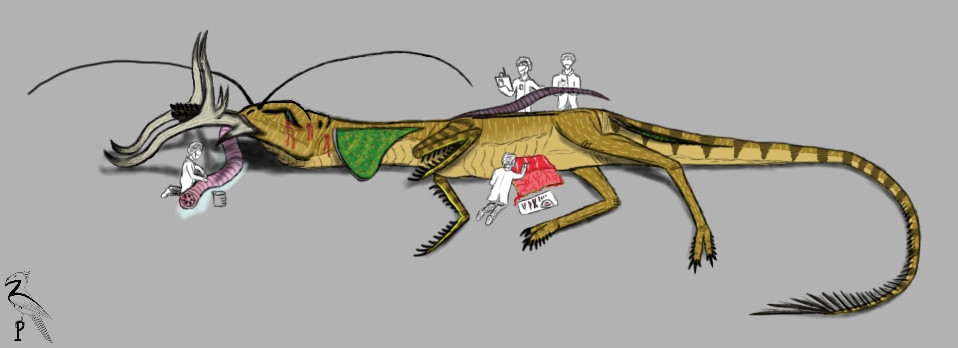HOME | DD
 ZoPteryx — Dissection of the Staglizard
ZoPteryx — Dissection of the Staglizard

Published: 2014-04-18 04:23:33 +0000 UTC; Views: 2561; Favourites: 31; Downloads: 8
Redirect to original
Description
A troop of Earth primates begin disassembling a "bull" (which simply describes its possession of "antlers", these are hermaphrodites) Zebra-tailed Staglizard (Stagosaurus savannensis) so its internal anatomy can be studied. "Staglizards" (aka "dinocrickets", aka "phallusbacks") are an incredibly diverse group of Kygorian "vertebrates", occupying such varied niches as small herbivores to top predators, such as this one. They are part of a larger group known as Parachoradates, which range from marine sea cucumber-like scavengers to the mighty staglizards; but all share a notochord composed of helical fibers, six pairs of limbs (the first pair is often modified into mandibles), and a back-mounted reproductive organ.There is much more to say about these creatures, such as their unique reproductive system and the symbiotic microbes that inhabit their erectable fins, but I'll save that for when I have a more fitting image of the family; one that shows the creatures alive, not riddled with 50 caliber shots to the head.
Background to Kygor.
Made in Sketchbook Express
Related content
Comments: 13

Hee hee... "...riddled with 50 caliber shots in the head." ...nice. I also like your referring to humans as "Earth primates"
👍: 0 ⏩: 1

If they're hermaphrodites, why do only some of them have antlers?
👍: 0 ⏩: 1

During the breeding season all members of a given population develop antlers, provided they are mature and in good health. They then engage each other in ritualized combat to determine the fitness of their prospective partners. The dominant individual in the fight gets to choose if it wishes to mate with loser, or it may choose to engage other individuals.
👍: 0 ⏩: 0

That's a big lizard. Phallusback is an interesting name.
👍: 0 ⏩: 1

It is indeed, though this about as big as they get. There are larger Kygorian creatures though.
Phallusback is a tongue-in-cheek reference to that purple tentacle-like appendage those two scientists are holding. The name never really caught on in scientific circles; the media loved it though!
👍: 0 ⏩: 1

I thought the name might refer to that organ. What do it do?
👍: 0 ⏩: 1

The organ, which is usually stored between two ridges (not visible in this drawing) and covered by a mucus cocoon, is mobile and porous. After a bout of ritualized combat, staglizards stand side by side and intertwine their organs, wringing them out and releasing their "sperm". When they unwind, the pores open up and absorb the "sperm" which then travels down into the body to find the unfertilized eggs. It's a messy process and much of the "sperm" (up to half) that gets absorbed is actually the staglizard's own! This has an interesting side effect: some of the resultant offspring will be clones of the parent while the others will be normal. A bizarre survival strategy for an often harsh environment. Some species try to counter this by having special ridges on their reproductive organ that reduce the likelihood of reabsorption, while others simply devour cloned offspring. Those species living in particularly harsh environments where finding a mate is difficult may do just the opposite, twisting their organ into knots in order to, essentially, mate with themselves and produce and entire batch of clones!
👍: 0 ⏩: 1

Interesting system. It kind of reminds me of Komodo dragons, how they can self fertilize.
👍: 0 ⏩: 0

Wow, great work! Looking forward to more of Kygor!
👍: 0 ⏩: 1

























